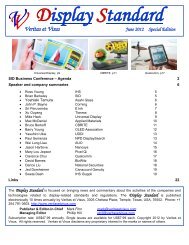Create successful ePaper yourself
Turn your PDF publications into a flip-book with our unique Google optimized e-Paper software.
<strong>Veritas</strong> <strong>et</strong> <strong>Visus</strong> <strong>Display</strong> <strong>Standard</strong> February 2009<br />
Innovation, partnership, and death:<br />
the new economics of HDTV semiconductors<br />
by Christian Prusia<br />
Christian R. Prusia is chairman of <strong>Display</strong> Insights, a multidisciplinary team that researches<br />
and consults within the HDTV semiconductor mark<strong>et</strong>. Prior to <strong>Display</strong> Insights, Mr. Prusia<br />
held numerous leadership positions within the consumer electronics industry; including<br />
positions at InFocus, Pixelworks, and Enuclia Semiconductor (where he was co-founder and<br />
CEO). Mr. Prusia earned a Master of Business Administration (MBA) from Willam<strong>et</strong>te<br />
University's Atkinson School of Management as well as a B.A. from the University of Pug<strong>et</strong><br />
Sound. Both degrees include specialized concentrations within the area of quantitative and<br />
qualitative mark<strong>et</strong>ing research.<br />
<strong>Display</strong> Insights’ new report “Innovation, Partnership, and Death: The New Economics of<br />
HDTV Semiconductors” takes a d<strong>et</strong>ailed look at the costs and opportunities within HDTV<br />
semiconductors amid the 2009 global climate. The report includes company-specific analysis<br />
across 92 individual semiconductor manufacturers (50 privately held) including the leading<br />
silicon tuners, demodulators, MPEG processors, image processors, and interconnects (including wireless transceivers).<br />
Company-specific analysis includes: d<strong>et</strong>ailed block diagrams (120Hz, ultra-thin, MPEG-4); individual component<br />
pricing (ASPs), technology roadmaps; design wins; and positional forecasts. http://www.displayinsights.com<br />
Inundated with inventory, rapid price declines, bankruptcies and governmental bailouts, there is little debate that<br />
the worldwide semiconductor ecosystem is facing a challenging 2009. January opened with China’s largest<br />
chipmaker, Semiconductor Manufacturing International, structuring a government-backed infusion of $170 million<br />
combined with a larger than expected quarterly loss. Germany’s Qimonda followed by filing for bankruptcy and<br />
Korea’s Samsung Electronics reported its first-ever quarterly loss. Adding to the negative momentum, Japan’s<br />
Toshiba and NEC Electronics posted Q4 losses, followed by Pioneer Corp. announcing, it will g<strong>et</strong> out of the TV<br />
business altog<strong>et</strong>her while trimming 10,000 jobs.<br />
The severity of the global semiconductor mark<strong>et</strong> was described as “desperate”, by Daniel Heyler, head of global<br />
semiconductor research for Merrill Lynch in Hong Kong. 1 And Daniel is not alone in his opinion. In December,<br />
iSuppli announced semiconductor inventories would escalate by more than 250%, reaching $10.2 billion at the end<br />
of December, up from September’s $3.8 billion. This was followed by the Semiconductor Industry Association‘s<br />
February report that outlined global semiconductor sales declined by 16.6% across December, typically one of the<br />
strongest months for the industry. The SIA also reported total ’08 semiconductor sales were down 2.8% Y/Y,<br />
reaching only $248.6 billion compared to $255.6 billion in ’07. According to Gartner, economic pressures will<br />
continue throughout ‘09, with worldwide semiconductor revenues forecast to recede to $219.2 billion, a decrease of<br />
more than 11% Y/Y.<br />
Short-term impact: high inventories, price erosion, and general discomfort: The reduction in consumer<br />
electronics demand across Q4’08 and early Q1’09 has undoubtedly placed tremendous pressure on the average<br />
HDTV bill-of-materials (BOM). Y<strong>et</strong> price compression appeared most volatile across HDTV system memory<br />
manufacturers and the flat panel glass manufacturers themselves. This is due to the intense capital requirements<br />
both the memory and panel infrastructures necessitate, combined with their standardized production practices. 2<br />
Industry insiders agree that memory and panel manufacturers experience fixed costs ranging b<strong>et</strong>ween 75% and 85%<br />
respectively, so as consumer demand wavers, these manufacturers continue to flood the mark<strong>et</strong> in an effort to<br />
protect mark<strong>et</strong> share at the cost of fueling further price erosion.<br />
In contrast to the rapid declines across HDTV-related memories and panels, the average HDTV system<br />
semiconductor BOM has weathered the recent turmoil well. According to <strong>Display</strong> Insights, the average HDTV<br />
96






